Life in Lannion
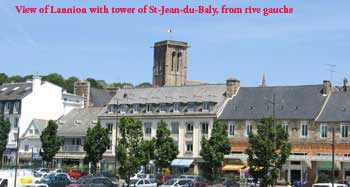 Back from the States now for a week, we finally have time to post some photos of our apartment and Lannion, our home town for the next year. Now that we are settling in, we are even more impressed with our good luck in finding this flat above M. Faggi’s shop. Our apartment is spacious (by French standards), sunny, and right on le Léguer, the river that runs through Lannion and then empties into the sea about 5 miles from here. There are hiking paths along the river both upstream and downstream from us.Our place is part of a row of stone
Back from the States now for a week, we finally have time to post some photos of our apartment and Lannion, our home town for the next year. Now that we are settling in, we are even more impressed with our good luck in finding this flat above M. Faggi’s shop. Our apartment is spacious (by French standards), sunny, and right on le Léguer, the river that runs through Lannion and then empties into the sea about 5 miles from here. There are hiking paths along the river both upstream and downstream from us.Our place is part of a row of stone 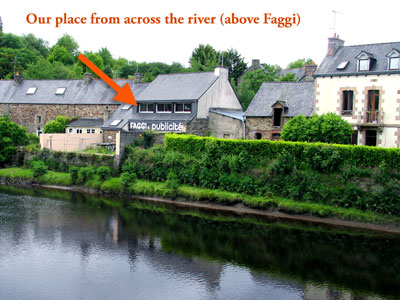 houses, although our building has been completely renovated and stuccoed over on the outside. Windows run across the entire eastern side of our combined living room/dining room/kitchen and we have sweeping views of le Léguer. It is a delight to observe the river under constantly changing states of
houses, although our building has been completely renovated and stuccoed over on the outside. Windows run across the entire eastern side of our combined living room/dining room/kitchen and we have sweeping views of le Léguer. It is a delight to observe the river under constantly changing states of  light, wind, and tide. From time to time, kayakers pass by; the other day a class of middle schoolers was out with their instructors. We expect to be out on the river ourselves soon. There is a fairly busy street on the far side of the river, but the windows are double glazed and shut out the traffic noise.
light, wind, and tide. From time to time, kayakers pass by; the other day a class of middle schoolers was out with their instructors. We expect to be out on the river ourselves soon. There is a fairly busy street on the far side of the river, but the windows are double glazed and shut out the traffic noise.
Our apartment has two bedrooms (hint to anyone contemplating a visit: you will have a bedroom to yourself) and the one large room for everything else. The kitchen is a distinct space, separated by the counter that is visible in the photo. The place is fully furnished, including a basic battery de cuisine, and has a fireplace for those chilly winter evenings. 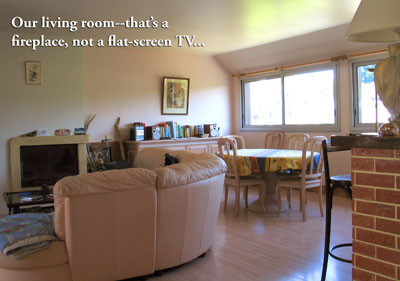
Our location couldn’t be better. A right turn outside our front door takes us within minutes to the center of Lannion, where there is a 16th-cent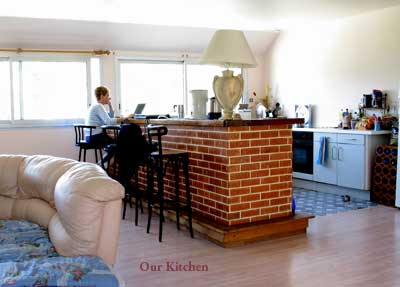 ury church, 400-year-old stone and timber-framed houses, a market two days a week, the butcher, several bakers, the cheese shop, etc. A left turn gets us into the countryside within 10 minutes, among stone barns and fieldstone fences, goats, cows, and sheep. Almost all farmhouses and barns are made from the wonderful local stone and are almost embarrassingly picturesque. The older farm fields are separated by stone fences.
ury church, 400-year-old stone and timber-framed houses, a market two days a week, the butcher, several bakers, the cheese shop, etc. A left turn gets us into the countryside within 10 minutes, among stone barns and fieldstone fences, goats, cows, and sheep. Almost all farmhouses and barns are made from the wonderful local stone and are almost embarrassingly picturesque. The older farm fields are separated by stone fences.
Lannion is an interesting mix of old Bretagne and modern France. France Telecom built a major research lab here in the 1970s, which in turn has attracted a fair amount of other high-tech firms to the area. As a consequence, the population is significantly better educated and more 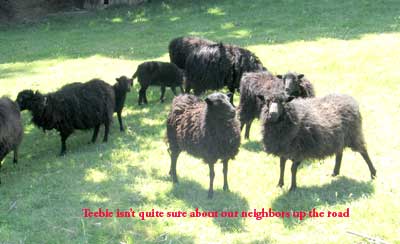 sophisticated than one would encounter in the typical city of 20,000+.
sophisticated than one would encounter in the typical city of 20,000+.
Lannion supports a very good new bookstore and one decent used bookstore. There is also a pretty extensive series of concerts and recitals, which feature everything from classical to traditional Bretagne to jazz to African and Latin American music. We are eagerly awaiting a two-week organ festival in various churches in and near Lannion in August.
.
Old town Lannion is built on hills, with many narrow medieval streets. The older houses have a stone first floor and then half-timbering above. Often the upper stories project slightly over the first story. (Many times we have been told that this was done so that the contents of chamber pots dumped from upper windows would 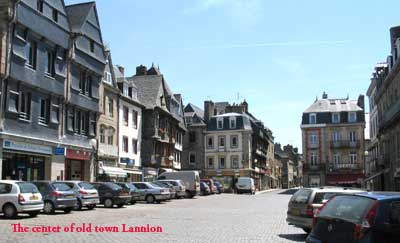 land in the middle of the street not on passers-by walking close to the walls, but this sounds questionable to me.) Beginning about 3 centuries ago, almost all townhouses were made from stone. The place du centre has buildings from many periods and is full of life, especially on Thursday morning, when the major weekly market takes place. Saint-Jean du Baly, the major church in town, dates to the 1500s (its square tower is visible in the photo). L’église de Brélévenez, at the top of the steps behind Ellen and Martin, is in many ways more interesting. Portions of it
land in the middle of the street not on passers-by walking close to the walls, but this sounds questionable to me.) Beginning about 3 centuries ago, almost all townhouses were made from stone. The place du centre has buildings from many periods and is full of life, especially on Thursday morning, when the major weekly market takes place. Saint-Jean du Baly, the major church in town, dates to the 1500s (its square tower is visible in the photo). L’église de Brélévenez, at the top of the steps behind Ellen and Martin, is in many ways more interesting. Portions of it 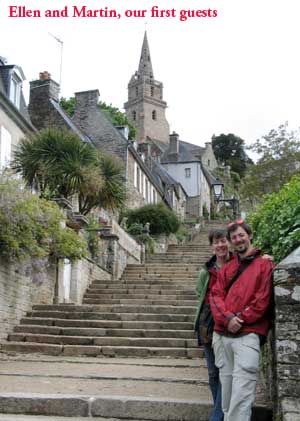 date to the 12th century, and its construction is traditionally associated with the Knights Templar. It has some marvelous weathered stone carvings around the south portal.
date to the 12th century, and its construction is traditionally associated with the Knights Templar. It has some marvelous weathered stone carvings around the south portal.
The coast here is dotted with close-in islands (some set aside as bird sanctuaries), and half-day and full-day sailing excursions are offered. We have finally decided to lease a car or buy a used one, having learned that Brittany is full of country churches, roadside calvaires (stone crucifixes, often with carvings of Bible scenes as well), and stone-age archeological sites. Without a car to tool around in, we would miss many of these and many serendipitous discoveries, as well.
I have made a preliminary reconnaissance of my friend Gérald’s library and find that is full of the classics of French literature, mostly sets from the 18th century, all leather bound. There are many histories and religious tomes, but also the works of Voltaire, Rousseau, Boileau, Moliere, Racine, and Buffon, the great French naturalist. It will truly be a labor of love to catalogue the library.
This gives some idea of our milieu; we will add to the story as we get to know the place better.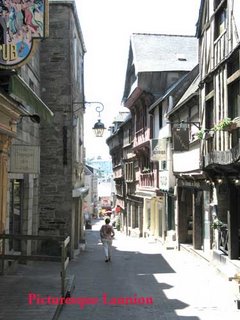
Update & two weeks in Provence
We have been very busy with our French classes and excursions in Provence and so have not been able to post in a while. Also, we did not have an Internet connection in our apartment in Aix, and had to rely on the computers at school, which were in heavy demand. We are now back from our time in Provence and our brief trip to the States to participate in the graduation of my nephew, Chris, from Brown University (magna cum laude and Phi Beta Kappa). Also spent a couple of days with Madeline’s mom in Oberlin. She is doing quite well, all things considered, although only speaking a word now and again. We have prepared this post on Provence; in the near future we will have additional posts on our apartment here in Lannion and other matters of potential interest.
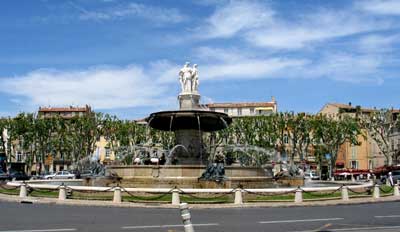
We thoroughly enjoyed our two weeks in Provence (Aix's Fountaine de la Rotunde above), which has yet to be completely spoiled by the influx of tourists and rich Parisians who have been attracted to the region by Peter Mayle’s books and the TGV trains that can whisk you from Paris to Marseilles in less than four hours. TGV stands for trains de grande vitesse, or very fast trains. (The French love to apply initials to everything.) Our last day in Aix was as close to perfect as a day can be. We went on a ramble in a regional park with views of Mount Saint-Victoire, a favorite subject for Cézanne. The sky was the cerulean blue that painters love, the sun was shining, and there was a touch of the mistral wind to keep the heat from being oppressive. Provence doesn’t get all that much rain and the soil is rocky. Vegetation is sparse, mostly pines and cypresses, tenacious shrubs like a variety of holly with tiny leaves, wild flowers, and wild herbs like rosemary and thyme. 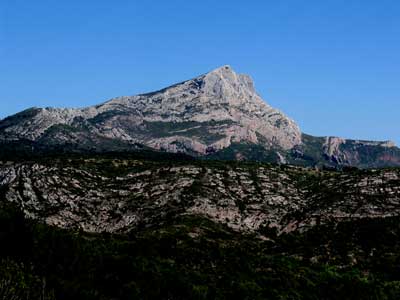
Mount Sainte-Victoire is not all that tall as mountains go, about 1,800 feet, but it is more a ridge that a mountain and so dominates the countryside. The southern face is without vegetation; its pale limestone expanse stands out sharply against the sky. Surrounding the mountain are valleys and ravines with steep slopes. Some of the rivers have been dammed, and the reservoirs are a blue-green that seems almost unreal. We walked for a little more than an hour with our local guide and two students from school, a Dutch woman and a German one.
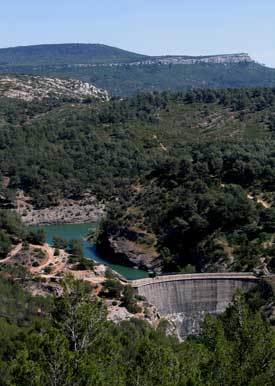
Upon our return, we dined in the garden of our studio apartment in Aix. Our apartment was attached to the home of Madame Desandre at the end of a dead-end street about 10 minutes by foot from IS, the language school where we had two weeks of classes. Madame loves to garden, and we picked a pound of her cherries, now at their peak in Provence, for our dessert. Madame also has apple, apricot, fig, and almond trees in her yard. When she made dinner for us Wednesday, she seasoned the vegetables with parsley from her garden. One of the joys of our year in France will be to devour each fruit and vegetable as it comes into season. We have already had exquisite strawberries, white and green asparagus, and cherries. Out-of-season fruit from Africa and South America is available in France, but the French don’t eat much of it, preferring perfectly fresh fruit (and vegetables) that were not picked before ripening. Our dinner was accompanied by a rosé, a wine that is produced in huge quantities in Provence, accounting for about 80 percent of regional production. Much of it is made from Syrah grapes, although some Grenache and Mourvedre are also used. There are a few good red wines there, too, notably those of Bandol and Bellet. Not m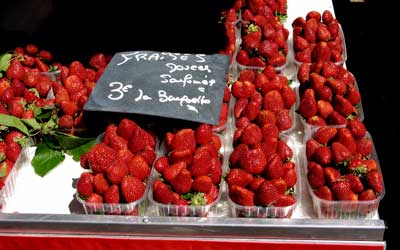 uch white is made.
uch white is made. 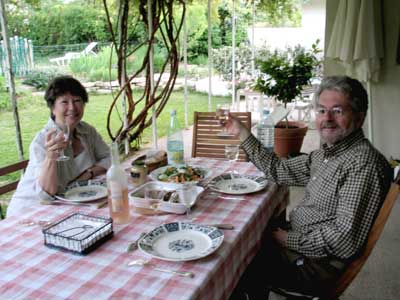
Aix is a charming city of 180,000 people, notable for its universities and more than thirty fountains in the old city. It has, alas, become more and more tourist-oriented of late, especially in this year of Cézanne. Cézanne died in Aix one hundred years ago, and the Aixois are compensating for their neglect of him while he was alive by cashing in big time during his centennial year. Like many of the cities in Provence (Marseilles, Arles, Nîmes), Aix was part of the Roman Empire, although no ruins survive in Aix.
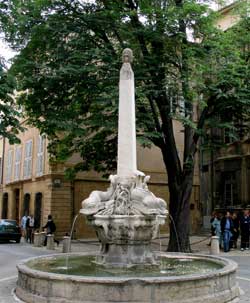
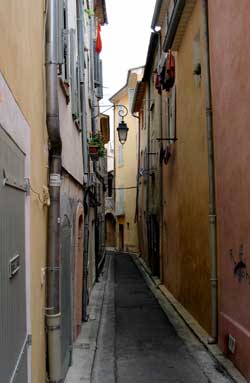
The city’s period of greatest prosperity was the late 17th and most of the 18th century. At this time, successful merchants and minor nobility built elegant townhouses in Aix (hôtels particuliers), and many of these survive. Their facades are crafted from a local stone with a pleasing pale ochre tint to it. The style is neoclassical (see facade below), with an occasional over-the-top baroque touch like exaggerated scrolls flanking a pediment or pilasters that take the form of larger-than-life-size male or female figures. The streets of the old city are narrow and not arranged in any discernable pattern, so we were frequently consulting our map. Many crossroads have fountains that vary from a single pipe in a basin to the lavish 19th-century fountain of the Rotonde (first picture above).
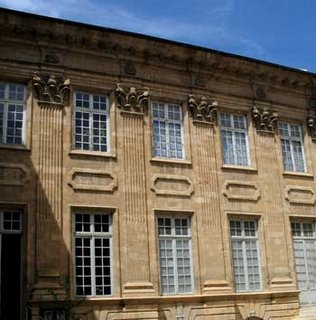
We liked our school a lot. The teachers are excellent, very dedicated and encouraging, which they need to be, considering the very wide range of nationalities and levels of ability they deal with. The school attracts students from all over, mostly from other European nations, but also Americans, Canadians, Japanese, Chinese, and the odd South American or African. We had a placement exam on the first day and Madeline landed in the top section while I fell two levels below. At school, I had English in common with the Australians, Canadians, and Swedes (almost all of whom learn English in school), but with the Dutch, Japanese, and Germans, I pretty much had to use my French. Madeline had a piquant experience the night we had a lesson in traditional Provencal cuisine. Ten of us were seated at a long table, and conversations were going on in German, Swedish, French and English—all languages that Madeline understands.
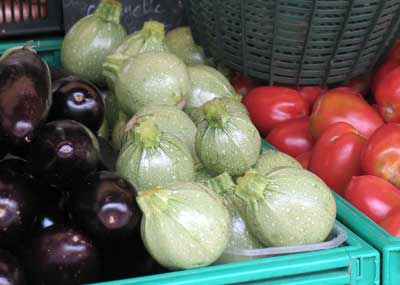
We had class for three hours each morning, and then a different activity every afternoon or evening. These included a lecture on and tasting of Provencal wine; an afternoon in Marseilles; a visit to Cézanne’s last studio; a guided tour of old Aix; and the hike and cooking lesson previously alluded to. Provencal cuisine is not haute cuisine, but country cuisine, based on locally available ingredients like olives, onions, garlic, eggplant, zucchini (we'd never seen spherical zucchini!) , bell peppers, various fruits, and nuts like the almond and pine nut. The most typical meat is lamb. People in Marseilles and other coastal towns ate fish and shellfish, but traditionally the inland areas of Provence didn’t get much fish, at least in the period before refrigerated trucks. The habitual Provencal cheese is chevre, made from goats’ milk. At our cooking lesson/feast, we had thin slices of eggplant stuffed with chevre, deboned leg of lamb stuffed with an olive/onion/garlic/herb mix, and a lemon tart.
Before arriving in Aix, we spent two days in Nîmes, and we also had a day-long excursion arranged by the school to Avignon and a small town known as Les Baux de Provence. We will try to post some commentary and photos on those places in the future.
I will close with some Aixois experiences that confirm for me that jazz is truly a universal language. Upon our arrival in Aix, as Madame was driving us down the Cours Mirabeau, a boulevard of cafés and tony shops, a trio was playing “All the Things You Are.” Later we learned that Madame’s son is a jazz drummer, and played with Gil Evans on his last European tour. Madame herself is musical, singing in a jazz-oriented chorus whose style and repertory are reminiscent of Manhattan Transfer. Madame played a CD of her group, which included very nice arrangements (done by a group member) and quite creditable versions of “A-Tisket-A-Tasket” and “Sing, Sing, Sing,” complete with some scat singing. The accents were a bit weird, but the music was great! (Below a "mouse" of lamb and grilled eggplant that we enjoyed in Nimes.) 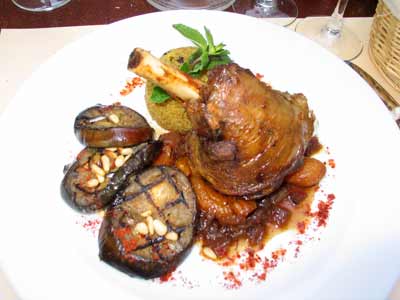
 Back from the States now for a week, we finally have time to post some photos of our apartment and Lannion, our home town for the next year. Now that we are settling in, we are even more impressed with our good luck in finding this flat above M. Faggi’s shop. Our apartment is spacious (by French standards), sunny, and right on le Léguer, the river that runs through Lannion and then empties into the sea about 5 miles from here. There are hiking paths along the river both upstream and downstream from us.
Back from the States now for a week, we finally have time to post some photos of our apartment and Lannion, our home town for the next year. Now that we are settling in, we are even more impressed with our good luck in finding this flat above M. Faggi’s shop. Our apartment is spacious (by French standards), sunny, and right on le Léguer, the river that runs through Lannion and then empties into the sea about 5 miles from here. There are hiking paths along the river both upstream and downstream from us. houses, although our building has been completely renovated and stuccoed over on the outside. Windows run across the entire eastern side of our combined living room/dining room/kitchen and we have sweeping views of le Léguer. It is a delight to observe the river under constantly changing states of
houses, although our building has been completely renovated and stuccoed over on the outside. Windows run across the entire eastern side of our combined living room/dining room/kitchen and we have sweeping views of le Léguer. It is a delight to observe the river under constantly changing states of  light, wind, and tide. From time to time, kayakers pass by; the other day a class of middle schoolers was out with their instructors. We expect to be out on the river ourselves soon. There is a fairly busy street on the far side of the river, but the windows are double glazed and shut out the traffic noise.
light, wind, and tide. From time to time, kayakers pass by; the other day a class of middle schoolers was out with their instructors. We expect to be out on the river ourselves soon. There is a fairly busy street on the far side of the river, but the windows are double glazed and shut out the traffic noise.
 ury church, 400-year-old stone and timber-framed houses, a market two days a week, the butcher, several bakers, the cheese shop, etc. A left turn gets us into the countryside within 10 minutes, among stone barns and fieldstone fences, goats, cows, and sheep. Almost all farmhouses and barns are made from the wonderful local stone and are almost embarrassingly picturesque. The older farm fields are separated by stone fences.
ury church, 400-year-old stone and timber-framed houses, a market two days a week, the butcher, several bakers, the cheese shop, etc. A left turn gets us into the countryside within 10 minutes, among stone barns and fieldstone fences, goats, cows, and sheep. Almost all farmhouses and barns are made from the wonderful local stone and are almost embarrassingly picturesque. The older farm fields are separated by stone fences.  sophisticated than one would encounter in the typical city of 20,000+.
sophisticated than one would encounter in the typical city of 20,000+.  land in the middle of the street not on passers-by walking close to the walls, but this sounds questionable to me.) Beginning about 3 centuries ago, almost all townhouses were made from stone. The place du centre has buildings from many periods and is full of life, especially on Thursday morning, when the major weekly market takes place. Saint-Jean du Baly, the major church in town, dates to the 1500s (its square tower is visible in the photo). L’église de Brélévenez, at the top of the steps behind Ellen and Martin, is in many ways more interesting. Portions of it
land in the middle of the street not on passers-by walking close to the walls, but this sounds questionable to me.) Beginning about 3 centuries ago, almost all townhouses were made from stone. The place du centre has buildings from many periods and is full of life, especially on Thursday morning, when the major weekly market takes place. Saint-Jean du Baly, the major church in town, dates to the 1500s (its square tower is visible in the photo). L’église de Brélévenez, at the top of the steps behind Ellen and Martin, is in many ways more interesting. Portions of it  date to the 12th century, and its construction is traditionally associated with the Knights Templar. It has some marvelous weathered stone carvings around the south portal.
date to the 12th century, and its construction is traditionally associated with the Knights Templar. It has some marvelous weathered stone carvings around the south portal.










